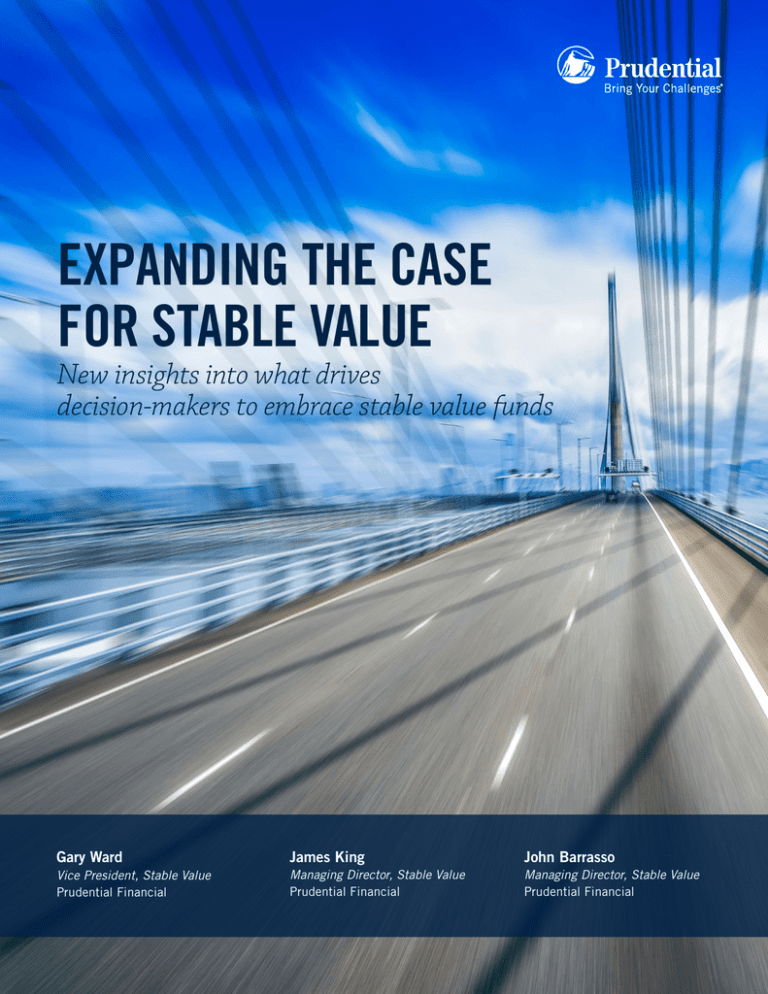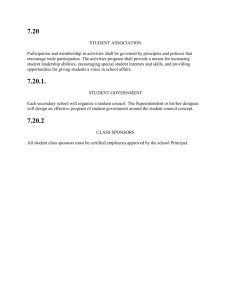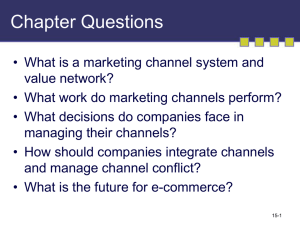Expanding the Case for Stable Value
advertisement

EXPANDING THE CASE FOR STABLE VALUE New insights into what drives decision-makers to embrace stable value funds Gary Ward James King John Barrasso Vice President, Stable Value Prudential Financial Managing Director, Stable Value Prudential Financial Managing Director, Stable Value Prudential Financial EXECUTIVE SUMMARY For more than four decades stable value investments have been a core investment option in defined contribution retirement savings plans, delivering a unique combination of steady returns and principal preservation guarantees that many plan participants find highly attractive. Returns from stable value funds have outpaced those available from money market funds, their most common competitor, with no increase in volatility.1 To find out, Prudential surveyed more than 400 plan sponsors and 300 intermediaries (advisors and consultants who work with sponsors). We asked which factors they consider when choosing investment options for their retirement plans, what drives them to adopt stable value, and what triggers them to recommend stable value to others. From those who have not yet embraced the asset class, we learned what’s holding them back. Still, the percentage of defined contribution plans offering stable value funds has been below 50 percent for years,2 leaving significant numbers of plan participants without access to the asset class. Stable value proponents know what those participants are missing: the combination of steady returns and principal protections that only stable value funds offer, and the comfort and confidence that can come from including this volatility-dampening investment in their retirement portfolios. But what about plan sponsors who’ve elected not to include stable value funds on their investment menus? What are they missing? And why? But our findings go further. They suggest that plan sponsors and intermediaries who haven’t adopted stable value may be doing a disservice to their plan participants. Those who have adopted stable value associate it with improved plan participation and participant deferral rates, both of which can drive better participant outcomes Dr. David Babbel and Dr. Miguel A. Herce, “Stable Value Funds: Performance to Date,” The Wharton School, January 2011. Additional summarization provided by Babbel and Herce, February 2011, Stable Value Investment Association, Annual Investment Policy Surveys: 2008-2014. 2 Stable Value Investment Association. 1 2 Among the survey’s other key findings: •• A significant percentage of stable value non-adopters say they are planning to offer or recommend stable value in the next three years. At the same time, very few adopters are considering dropping it from their retirement plan’s list of investment options. •• The top characteristics that drive plan sponsors and intermediaries to adopt stable value are capital preservation and steady, guaranteed returns. •• Other adoption triggers include the liquidity of the asset class for plan participants, and a perception that stable value helps deliver better returns than other fixed-income investments. •• Thirty percent of intermediaries who do recommend stable value say they are doing so more this year than they did last year, and 35 percent say they expect that trend to accelerate over the next three years. •• Key issues that keep some sponsors and intermediaries from adopting stable value funds include the sense that they are more complicated and less transparent than other investment options, that their performance trails that of non-fixed-income investments and that they have higher expenses. •• Sponsors and intermediaries alike are receptive to the idea of making stable value a more common component of targetdate funds, one of the fastest-growing investment options in DC plans. •• Both adopters and non-adopters of stable value recognize the positive attributes of the asset class, but for non-adopters the perceived negatives register more strongly. These findings should resonate with plan sponsors and intermediaries still weighing the benefits of stable value and seeking to understand its values more deeply. They demonstrate that: •• The factors that drive plan sponsors and intermediaries to recommend stable value funds differ in many cases from those that drive them to actually adopt stable value—and aren’t always among the factors they prize most when considering investment options for their plans. •• Stable value is not just a niche principal-preservation product, but can function as the conservative foundation of a well-designed investment portfolio—and as a core component of target-date funds. Encouragingly, Prudential’s survey provides evidence that growing numbers of plan sponsors and intermediaries may be open to embracing the asset class. •• The perceived challenges of stable value are tradeoffs that can make sense for retirement savings plans and their participants. In other words, the benefits of the asset class can justify its costs and distinctive characteristics. •• Recent Securities and Exchange Commission rule changes pertaining to money market funds have dimmed the appeal of those funds and may drive some plan sponsors to replace them with stable value funds. •• Stable value can function as a diversification tool for investors of any age—a tool with protection features that, by helping participants overcome their investment fears, can boost plan participation and participant deferral rates. And that can help drive better participant outcomes. THE CASE FOR EXPANDING STABLE VALUE’S REACH Stable value’s performance through the financial crisis has been lauded for good reason. When returns from virtually every other asset class were tumbling in 2008, stable value funds delivered returns of more than 4 percent for their investors on average—then continued to deliver positive returns in each succeeding year.3 Not only did stable value perform as designed during the crisis, it became fundamentally stronger in its aftermath. Since 2009, stable value investment guidelines on the synthetic side of the business have been further strengthened, and stable value fees have increased commensurate with the risks assumed by stable value providers. While several wrap issuers exited the business in the immediate aftermath of the crisis, new 3 4 players have since entered, resolving a wrap-capacity shortage that could have threatened the industry’s viability had it gone unaddressed. It took a significant effort by market participants—plan sponsors, stable value managers, wrap issuers, consultants and advisors, attorneys and others—to retool and rebuild the stable value market. But those efforts paid off. Today wrap capacity is abundant, and the stable value market has never been in better structural shape. It’s also growing, albeit not quite as fast as the defined contribution plan market overall. From December 2009 through December 2014 assets in insurance company general account stable value products grew to $375 billion from $220 billion, a gain of 70 percent.4 Meanwhile, assets Stable Value Investment Association, Annual Investment Policy Surveys: 2008-2014. Stable Value Investment Association annual and quarterly Stable Value Investment & Policy Surveys of SVIA members, 2009-2014. 3 in the wrap sector of the market grew to more than $380 billion from $313 billion, a gain of 22 percent. By June 2015, total stable value assets had reached $770 billion, representing about 11 percent of all assets in defined contribution plans.5 Nonetheless, the number of defined contribution plans offering stable value funds has continued to hold at about 50 percent.5 Certainly the growing popularity of target-date funds explains some of what has been happening. But Prudential’s newest stable value survey provides additional insights into why more plan sponsors and intermediaries are not taking advantage of the asset class. It finds, for example, that stable value is less well known than some other investment options, including money market funds and mutual funds—and familiarity is a key driver of acceptance in the marketplace. On the surface, this utilization rate seems illogical. Stable value funds historically have delivered better returns than money market funds, their closest competitors, with no more volatility.6 They offer reassuring book-value withdrawal guarantees that aren’t available from other asset classes. They can function as an important diversifier, and conservative foundation, in investment portfolios for retirement savers of all ages, including risk-averse millennials who otherwise might be leery of investing. And strictly from a plan sponsor’s perspective, stable value can help plans comply with section 404(c) of the Employee Retirement Income Security Act, which provides a fiduciary safe harbor to plans that offer participants a broad range of investment options with varying levels of risk. Meanwhile, even sponsors and intermediaries who are familiar with the product sometimes focus more on its perceived challenges than on the very real benefits it delivers. This paper takes an in-depth look at these and other issues relating to how plan sponsors and intermediaries view stable value. It identifies what those who are using the asset class like about it, and what those who are not cite as their concerns. Finally, drawing from this point forward on the survey results, it shows why more widespread use of stable value by plan sponsors who have not yet adopted it could help more Americans realize their retirement savings and investing goals. ADOPTERS AND NON-ADOPTERS FOCUS ON DIFFERENT ATTRIBUTES OF STABLE VALUE Plan sponsors and intermediaries who have adopted stable value cite two principal reasons for doing so: capital preservation and steady returns. Among these adopters, more than half of plan sponsors and nearly three-quarters of intermediaries identify these as stable value’s most compelling benefits. But they say they also appreciate stable value for delivering a wide range of secondary benefits, including guaranteed returns and “better” returns than other fixed-income investments. A quarter or more also say the asset class helps to increase plan participation rates and boost the amounts participants save. may be difficult for plan participants to understand. Nonadopting plan sponsors also cite the restrictions embedded in stable value contracts, which can impact factors such as when plan participants can move money from a stable value fund to a competing fund. To be sure, few if any plan sponsors or intermediaries see stable value in black or white terms; each associates both positive and negative attributes with stable value funds. Interestingly, stable value adopters and non-adopters recognize the strengths of stable value to roughly the same degree, but non-adopters are more sensitive to its perceived challenges. For example, non-adopters are more likely to associate high expenses and a perceived lack of transparency with stable value funds. Non-adopting plan sponsors also are more sensitive to the contractual restrictions that come with stable value funds. Plan sponsors and intermediaries who haven’t adopted stable value focus less on the positives that matter most to adopters and more on the perceived challenges of the asset class. These perceived challenges include the cost of stable value funds, their performance relative to equities and other non-fixed-income asset classes, and the notion that they Stable Value Investment Association. Dr. David Babbel and Dr. Miguel A. Herce, “Stable Value Funds: Performance to Date,” The Wharton School, January 2011. Additional summarization provided by Babbel and Herce, February 2011, Stable Value Investment Association, Annual Investment Policy Surveys: 2008-2014. 5 6 4 STABLE VALUE ADOPTION Capital preservation, steady returns drive adoption of stable value TRIGGERS OF ADOPTION PLAN SPONSORS INTERMEDIARIES Preserves capital 54% 75% Steady returns 54% 70% Guaranteed returns 47% 34% Better returns vs. other fixed income 44% 30% Helps increase participation rates 38% 36% Helps increase savings rates 34% 25% Can be easily liquidated by participants 29% 30% Expenses, performance, complexity and transparency keep some from embracing stable value TRIGGERS OF NON-ADOPTION PLAN SPONSORS INTERMEDIARIES Tighter contractual restrictions 54% 34% Does not perform as well as other non-fixed-income investments 54% 66% Higher expense ratio 53% 69% Not as transparent 53% 51% More complicated 45% 58% Addtional burden on fiduciaries 41% 23% 5 STABLE VALUE RECOMMENDATION DRIVERS DIFFER FROM ADOPTION DRIVERS Ironically, the factors that drive plan sponsors and intermediaries to recommend stable value to others often differ from those that drove them to adopt the asset class in the first place. As noted, adoption decisions tend to focus on the ability of stable value to deliver capital preservation and steady returns. But recommendations often flow from the returns stable value funds deliver versus other fixedincome investments, their role in boosting plan participation and participant deferral rates, and, for intermediaries, their liquidity for participants. Drivers of stable value adoption, recommendation, can differ STABLE VALUE DRIVERS PLAN SPONSORS Adoption Capital preservation Steady returns in all market cycles Guaranteed returns Recommendation INTERMEDIARIES Adoption Recommendation Better returns vs. other fixed income Can be easily liquidated by participants Helps increase participation rates Helps increase savings rates STABLE VALUE VIEWED MORE FAVORABLY THAN MONEY MARKET FUNDS7 Stable value is viewed more favorably than its main competitor, money market funds—especially among intermediaries. About a quarter of plan sponsors and intermediaries could be considered “promoters” of stable value, meaning they rank themselves highly likely (9 or 10 on a scale of 0 to 10) to recommend the asset class to others. By contrast, they’re not nearly so keen on money market funds. 32 percent of sponsors and 56 percent of intermediaries could be considered “detractors” of money market funds, meaning they rank themselves unlikely (0 to 6 on a scale of 0 to 10) to recommend the products. That compares with 27 percent and 36 percent of sponsors and intermediaries, respectively, who are detractors of stable value funds. An easy way to visualize these differences is by netting the two extremes to create a “net promoter score,” or NPS, for each asset class. To do that, simply subtract the percentage of detractors from the percentage of promoters. Viewed this way, stable value has an NPS of 23 among larger plan sponsors who currently use it and 4 among larger intermediaries. Money market funds, by contrast, have NPSs of 10 and -29, respectively, among larger plans and intermediaries who use them. 7 Prudential Retirement, Stable Value Adoption Research. Among plan Sponsors and Intermediaries with between $250<$500M in assets 6 WHEN CONSIDERING INVESTMENT OPTIONS, SOME MAY OVERLOOK STABLE VALUE Survey results suggest that in some cases, sponsors and intermediaries may be overlooking stable value because they don’t strongly associate the asset class with the factors they focus on most when considering investment options. Specifically, sponsors and intermediaries prize investments that are easily understood by plan participants and offer higher long-term returns and lower fees—attributes not strongly associated with stable value. That said, attributes that are strongly associated with stable value play a secondary role in driving consideration of investment options. These include capital preservation, protection against market volatility, guaranteed returns, and liquidity for participants. Factors considered when evaluating investment options PLAN SPONSORS IMPORTANCE TIER INTERMEDIARIES TIER 1 (60%+) TIER 1 (60%+) •• Less complex for participants •• Higher long-term returns HIGHER IMPORTANCE •• Less complex for participants •• Lower fees for clients and participants •• Lower fees (for organization and participants) TIER 2 (50%+) TIER 2 (50%+) High •• Less fiduciary burden •• Higher long-term returns •• Liquidity for participants •• Less fiduciary burden •• Capital preservation •• Fewer contractual restrictions •• Advisor recommended •• Market volatility protection •• Liquidity for participants High •• Less contractual restrictions •• Guaranteed returns TIER 3 (40%+) •• Strong brand TIER 3 (40%+) Low Low •• Capital preservation •• Widely used •• Part of recordkeeper’s platform •• Strong brand TIER 4 (30%+) TIER 4 (30%+) Lowest •• Market volatility protection LOWER IMPORTANCE •• Widely used •• Highly recommended by other brokers •• Guaranteed returns 7 TRADEOFFS: KEY TAKEAWAYS FOR NON-ADOPTERS •• Returns vs. non-fixed-income investments. Stable value returns historically have been comparable to those available from intermediate-term bonds and significantly higher than inflation or money market returns. That said, the expected return of stable value funds is lower than the expected return of non-fixed-income investments such as equities. At issue here is the adequacy of returns over a lifetime of savings. While it’s true that a highly concentrated investment in stable value by a young plan participant probably wouldn’t provide the returns necessary for a quality retirement, that doesn’t mean stable value can’t function as a foundation asset class in a broadly diversified portfolio for plan participants of all ages. In fact, data from the Investment Company Institute and the Employee Benefit Research Institute show that there is age-appropriate use of stable value by plan participants. Those in their 20s hold, on average, about 8 percent of their retirement assets in stable value, while those in their 60s hold about 28 percent.8 While stable value does not provide the same level of expected return to investors as equities, it does work as a diversification tool and is not used inappropriately by most individuals. The factors plan sponsors and intermediaries cite for not adopting stable value suggest they may not fully appreciate the role those factors play in making stable value work. If so, the stable industry must recognize the opportunity to better make the necessary connections. The stable value attributes that non-adopters consider challenges are, in many cases, critical to delivering the benefits that make the asset class so appealing to their peers who have adopted it. Among the issues that bear further exploration and discussion: •• Contractual restrictions. The restrictions common to stable value contracts create a stronger, more sustainable product that allows stable value to deliver what investors want from it: steady returns, low volatility and guaranteed withdrawal benefits. Restrictions on competing funds, for example, discourage arbitrage between stable value funds and money market funds during periods of rapidly rising interest rates, minimizing the chances that stable value funds might have to liquidate some of their assets when their values are depressed. Restrictions on withdrawals during corporate events, such as a plan termination, provide similar protections. •• Expenses. No investment product should be judged on expenses alone; benefits also must be considered. Stable value delivers unique book-value withdrawal guarantees that can serve multiple objectives. They can assure preservation of principal for highly risk-averse investors, including those near or in retirement. And as noted earlier, they can give younger investors the confidence to invest a portion of their retirement savings in higher-risk asset classes, such as equities, that they’ll likely need to achieve their retirement goals. •• Returns versus other fixed-income investments and inflation. Numerous studies have shown that stable value funds have delivered steady, bond-like investment returns with low volatility through all types of investment environments and economic cycles. Most recently, a Prudential analysis of the 16-year period from 1999 through 2014 showed stable value returns outpacing both money market returns and inflation. Stable value modestly underperformed an intermediate-term bond index largely because the index incurred no trading costs and had a slightly higher duration. Money market funds, by contrast, failed to keep pace with inflation, resulting in negative real returns for investors. •• Transparency of Underlying Investments. Transparency can vary among the three main types of stable value products: pooled funds using wrap contracts, individually managed accounts using wrap contracts, and insurance company general account products. Many wrapped stable value products offer investors a direct view of the products’ investment composition. Some stable value products— primarily insurance general account products with fixed rates set in advance and guaranteed for a specific period—may be viewed by some as less transparent. Here again, however, plan sponsors and participants enjoy some potentially beneficial tradeoffs, as insurance general account products sometimes offer higher crediting rates and guarantee a return above 0 percent. These are factors plan sponsors, along with their consultants and advisors, can consider when making informed choices about which stable value products to offer. Stable value: a history of bond-like returns with low volatility AVERAGE ANNUAL RETURN 1999-2014 STANDARD DEVIATION OF RETURNS 1999-2014 Intermediate-Term Bonds* 4.82% 3.15% Stable value** 4.35% 1.23% Inflation*** 2.27% 1.06% Money market funds**** 1.93% 2.08% ASSET CLASS * Barclays U.S. Government/Credit Bond Index (12-month total return) **SVIA Net, 12-month return (12-month average), from Stable Value Investment Association Annual Stable Value Investment Policy Survey, 1999-2014 ***Consumer Price Index 1999-2014, Bureau of Labor Statistics ****iMoneyNet MFR Money Funds Index (annualized returns) 8 Employee Benefit Research Institute, “401(k) Plan Asset Allocation, Account Balances, and Loan Activity in 2013,” December 2014. 8 Non-adopters also may be overlooking the role stable value can play in improving participant outcomes. Thanks to their protection features, which address many plan participants’ fears, stable value funds can give participants the courage to participate earlier in retirement savings plans and elect higher deferral rates. This can yield long-term benefits for plan participants of all ages—namely, a bigger nest egg when they stop working—and can be especially helpful for millennials, whose plan-participation horizon is longest. Access to an asset class that can assuage fears about investing is particularly important in the current investment climate. A 2014 study9 found that a substantial proportion of consumers remain anxious about the stock market and would benefit from a safety net to regain confidence and start investing again. Specifically, 40 percent of affluent consumers said they disagree with the idea that the economy has recovered since the 2008 recession. They also disagree that they no longer have to fear another crash in the near future. For investors with these concerns, stable value offers an attractive value proposition. MULTIPLE FACTORS POINT TO GREATER USE OF STABLE VALUE IN THE FUTURE Plan sponsor and intermediary attitudes toward broader use of stable value are favorable. Among plan sponsors, 55 percent of non-adopters plan to offer stable value in the future, while only 9 percent of adopters are at risk of getting rid of it. Similarly, among intermediaries, 67 percent of non-adopters say they plan to recommend it in the future, while only 3 percent of adopters are at risk of stopping recommending it. Finally, 30 percent of intermediaries who recommend stable value to clients are doing so more often today than they did a year ago, and 35 percent expect this trend to accelerate over the next three years. The changing regulatory environment for money market funds could boost demand for stable value funds. More than half of sponsors and intermediaries who currently offer or recommend money market funds are familiar with recent SEC rule changes that, beginning in October 2016, will allow those funds to impose redemption fees, or temporarily halt redemptions, when the funds fall below certain liquidity thresholds. A third of those sponsors—and half the intermediaries—say the changes have had a negative impact on their view of money market funds. What’s more, 63 percent of sponsors that currently offer money market PLAN SPONSORS SELECTING) funds and 49 (%percent of intermediaries who currently recommend them say this is likely to drive changes in their 28% Government money market allocation to money market funds. That could lead to market share gains by stable value. Among sponsors, 39 percent of Short-term bonds 21% those who moved money out of a money market fund in the past year, or plan to do so in the next three years, switched 39% Stable value some of it to stable value funds or plan to do so. Among intermediaries, some of the proceeds Target datethe percentage moving 35% from money market funds to stable value was 52 percent. Money leaving money market funds might move to stable value 28% Government money market 8% Short-term bonds 39% 56% 52% Stable value 35% Target date Others Government money market 21% Stable value 7% INTERMEDIARIES (%(%SELECTING) INTERMEDIARIES SELECTING) PLAN SPONSORS SPONSORS (%(%SELECTING) PLAN SELECTING) Short-term bonds Others 29% Target date 7% Others 6% INTERMEDIARIES (% SELECTING) 9 2014 Phoenix Affluent Consumer Audit. Audience demographics: 35-64 years old with HH income and investable assets of $100K+. Government money market 8% 9 Short-term bonds 56% Target-date funds, which continue to grow in popularity in defined contribution plans, present a special opportunity for stable value. Plan sponsors and intermediaries alike say that adding a stable value component to target-date funds would provide investors with additional protection against market volatility and loss of principal. Among plan sponsors who already offer target-date funds in their plans, 74 percent say they are somewhat or very likely to consider incorporating a stable value component into those funds. Sixty percent of intermediaries say they feel the same. Finally, 48 percent of sponsors say that adding stable value to target-date funds is “very valuable” because it provides participants with a fixed income guarantee through retirement. Incorporating stable value in target-date funds makes sense for both plan sponsors and plan participants. As noted earlier, plan sponsors and intermediaries associate stable value with improved plan participation rates and higher participant deferral rates. Incorporating stable value into a target-date fund also can add a positive absolute return component to the fund and improve the fund’s Sharpe ratio, a widely followed measure of risk-adjusted returns. Automatic enrollment, and use of QDIAs, strengthen argument for pushing to incorporate stable value in 6% 21% 28% 45% target-date funds PLAN SPONSORS THAT HAVE AUTOMATIC ENROLLMENT IN THEIR PLANS 6% 6% Don’t28% know 21% No plans 28% No, but plan to in next 3 years 45%Don’t know Yes No plans 85% 45% 21% INTERMEDIARIES THAT RECOMMEND AUTOMATIC ENROLLMENT PLAN SPONSORS 21% 85% 10% Stable value 6% No, but plan to in next 3 years 28% Yes 45% Target date 30% 43% Balanced funds 17% Managed account DEFAULT INVESTMENT FOR AUTOMATIC ENROLLMENT Others Among Plan Sponsors that have automatic enrollment and a default option. (Single select) PLAN SPONSORS 10% Stable value Target date 30% 43% Balanced funds Others 1% Others 35% Stable value Target date 66% 50% Balanced funds 27% 3% 50% 27% Managed account INTERMEDIARIES Others 66% Balanced funds 17% Managed account 35% Stable value Target date Managed account 1% Among Intermediaries that recommend automatic enrollment and a default option. (Multiple select) INTERMEDIARIES 10 3% CONCLUSION Stable value’s long role as a core investment option in defined contribution plans is admirable. But with approximately half of plans not offering the asset class, its ability to help improve participant outcomes is limited. Expanding the ranks of plan sponsors and intermediaries who use and recommend stable value funds could help millions more plan participants reach their retirement savings and investing goals. Fortunately, the environment is conducive to broadening stable value’s role: •• Regulatory changes are prompting some plan sponsors and intermediaries to rethink their use of money market funds and could drive them to adopt stable value funds instead. •• Intermediaries are recommending stable value more this year than they have in the past, and expect to continue doing so in the years ahead. •• Target-date funds present special opportunities for growth. In short, expanding the use of stable value isn’t just desirable, it’s also doable. 11 280 Trumbull Street Hartford, CT 06103 prudential.com Insurance products are issued by Prudential Retirement Insurance and Annuity Company (PRIAC), Hartford, CT, or The Prudential Insurance Company of America (PICA), Newark, NJ. Both are Prudential Financial companies. Each company is solely responsible for its financial condition and contractual obligations. © 2016 Prudential Financial, Inc. and its related entities. Prudential, the Prudential logo, the Rock symbol and Bring Your Challenges are service marks of Prudential Financial, Inc. and its related entities, registered in many jurisdictions worldwide. 0286268-00005-00STABLEWPRE1 08/2016




